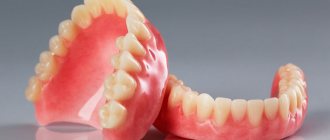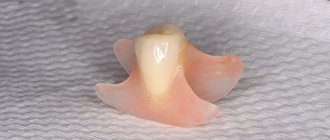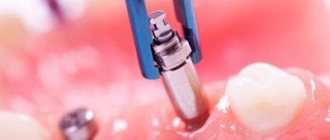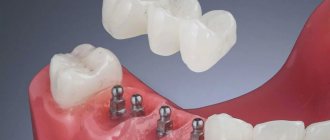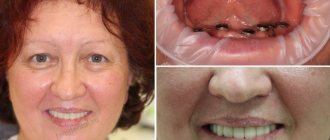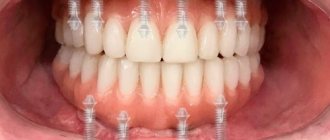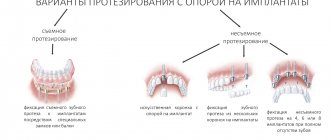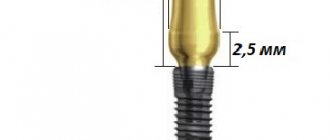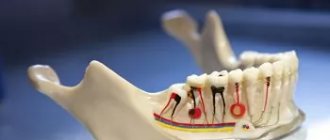Partial removable dentures are a simple and affordable denture option when one or more teeth are missing. They allow you to quickly restore aesthetics and functionality without surgical intervention. Within a week you will receive “new teeth”.
At our Center, partial dentures are manufactured in our own digital dental laboratory. The use of advanced materials, modern orthopedic protocols and the latest technologies allows us to create comfortable removable dentures that look as natural as possible and are a worthy alternative to implants.
How a partial denture is attached to the jaw
There are 3 options for fastening removable structures: hooks (clasps), locks (attachments), telescopic crowns.
We propose to consider each of the options in more detail. Clasps. They are hooks made of metal or plastic that grip healthy teeth and fix the orthopedic structure in the mouth. The disadvantage of such fastening is poor fixation and unsatisfactory aesthetics. Despite the fact that the hooks are covered by the lip, they are visible to others when smiling and talking.
Attachments. More preferable from an aesthetic point of view. The special lock consists of 2 parts. One element is built into the base of the prosthesis, and the other is attached to the crown that covers your own tooth. This fastening option has a more reliable fixation and gives the product stability. In addition, the attachments distribute the chewing load more evenly, which slows down bone atrophy by almost 2 times.
Telescopic crowns. Presented by a system consisting of 2 crowns. The inner one follows the contours of the ground tooth. The outer one is connected to the base and restores the shape of the tooth. This allows the prosthesis to be securely fixed and prevents it from moving. The possibility of installing a telescopic structure in each specific case is determined by the doctor, since grinding of a large layer of hard tissue of the supporting tooth is required.
Advantages
Partial dentures are a quick and affordable way to restore teeth without surgery.
- Cost They are much cheaper than implantation and do not require expensive surgical procedures or osteoplastic surgery.
- Speed: Production takes 1-2 weeks. For implantation with preparation, bone grafting and engraftment of implants - at least 4 months.
- Convenient When properly made from high-quality materials, taking into account the bite after adaptation, it feels like your own teeth in the mouth.
- Aesthetics Improved materials and modern orthopedic protocols make it possible to create prosthetics that are indistinguishable from natural teeth.
When using removable prosthetics, it is extremely important that the prosthesis is made not “by eye,” but taking into account the characteristics of the patient’s dentofacial apparatus. Otherwise, it is impossible to obtain a comfortable denture with the correct distribution of chewing load. This is fraught with constant inconvenience, gum injuries, rapid destruction of supporting teeth, the formation of a pathological bite, and dysfunction of the jaw joint.
Chashchin Kirill Valerievich
Orthopedic dentist, 14 years of experience
Digital prosthetics. Aesthetic restorations with veneers with a lifetime guarantee. Total orthopedic rehabilitation in one day
More about the doctor
Indications and contraindications for use
Partial removable dentures are used in cases where the jaw is missing only a few teeth, but there are own healthy teeth that will be used as supporting teeth. Suitable for restoring both chewing and front teeth. The use of removable partial dentures is recommended in the following cases:
- missing several teeth;
- end defects of the jaw;
- atrophied bone tissue;
- the need for temporary prosthetics;
- contraindications to the installation of implants.
There are practically no contraindications to this type of prosthetics, and they are all temporary. These include viral diseases, carious lesions of teeth and periodontal tissue diseases.
What is chewing efficiency
As you know, the oral cavity is also the beginning of the digestive tract. After preliminary thorough grinding, food enters the stomach through the esophagus. Therefore, a very important factor in healthy digestion is the concept of chewing efficiency - this is the work that is actually performed by the chewing apparatus, of which the teeth are an integral part. A loss of 40% of chewing efficiency is the limit that leads to digestive disorders and is an absolute indication for prosthetics.
Stages of manufacturing a removable partial denture
Depending on the type of prosthesis, the course of orthopedic treatment may differ slightly, but, in general, prosthetics can be divided into several main stages:
Preparation. After examination and diagnosis, the orthopedic doctor draws up a treatment plan and helps with choosing the optimal design option suitable for your particular case. At this stage, the oral cavity is sanitized. If necessary, teeth that cannot be saved are removed.
Taking impressions. Using impression material and a custom tray, the specialist takes impressions of the teeth on both jaws.
Manufacturing of the structure. In the dental laboratory, wax models are cast from the impressions, from which the technician makes the dentures.
Fitting and fixation. At the last visit, the doctor tries on the structure and fixes it in the oral cavity. If necessary, the prosthesis is adjusted and polished according to the bite.
Prices
Free online consultation with a dentist
| Service | Price |
| Installation of a temporary cosmetic plate (butterfly) | from 11,000 rub. |
| Installation of a complete or partially removable lamellar denture (acrylic, 1 jaw) | from 32,000 rub. |
| Installation of a partially removable nylon prosthesis (1 jaw) | from 40,000 rub. |
| Installation of a clasp denture with clasps (1 jaw) | from 40,000 rub. |
| Installation of a complete removable denture Akri Free (1 jaw) | from 47,000 rub. |
| Installation of a one-stage multi-unit implant with screw fixation (Switzerland, Trate AG) with an adaptation crown | from 50,000 rub. |
| Installation of a splinting clasp prosthesis (1 jaw) | from 55,000 rub. |
| Installation of a partially removable clasp prosthesis Quadrotti (1 jaw) | from 64,500 rub. |
| Installation of a locking clasp prosthesis (1 jaw) | from 70,000 rub. |
| Installation of a clasp denture on telescopic crowns (1 jaw) | from 75,000 rub. |
| Conditionally removable acrylic prosthesis on spherical attachments Rhein-83 for 1 jaw | from 121,000 rub. |
| Installation of a complete metal-plastic bridge prosthesis on one-stage implants of the ROOTT system (alloy Germany, plastic Japan - 1 jaw), cement fixation | from 130,000 rub. |
| Installation of a complete metal-plastic bridge prosthesis on one-stage implants of the ROOTT multi-unit system with screw fixation (Germany alloy, on a metal frame, Japan plastic - 1 jaw) | from 155,000 rub. |
| Installation of a complete metal-plastic bridge prosthesis on one-stage implants of the ROOTT multi-unit system with screw fixation (Germany alloy, on a titanium frame, Japan plastic - 1 jaw) | from 175,000 rub. |
| Installation of a full bridge ceramic-composite prosthesis on one-stage implants (Germany alloy, on a metal frame, Japan composite - 1 jaw) with cement fixation | from 230,000 rub. |
| Installation of a complete metal-ceramic bridge prosthesis on one-stage implants of the ROOTT system on a metal frame, 1 jaw, cemented fixation | from 210,000 rub. from 250,000 rub. promotion |
| Installation of a full bridge ceramic-composite prosthesis on one-stage implants (Germany alloy, on a titanium frame, Japan composite - 1 jaw) with cement fixation | from 250,000 rub. |
| Installation of a complete metal-ceramic bridge prosthesis on one-stage implants of the ROOTT multi-unit system with screw fixation, 1 jaw, metal frame | from 230,000 rub. from 270,000 rub. promotion |
| Installation of a complete bridge made of zirconium dioxide on one-stage implants of the ROOTT system, 1 jaw, cemented fixation | from 320,000 rub. |
| Installation of a complete PREMIUM ceramic-composite bridge prosthesis on one-stage implants of the ROOTT multi-unit system with screw fixation on a titanium frame CONDYLAR - stage II | from 320,000 rub. |
| Installation of a complete bridge made of zirconium dioxide on one-stage implants of the ROOTT multi-unit system with screw fixation, 1 jaw | from 370,000 rub. |
| Installation of a full bridge ceramic-composite prosthesis on one-stage implants of the ROOTT system on a reinforced titanium milling frame with a stump for each tooth of increased aesthetics on cement fixation, 1 jaw, stage II (SHOFU ceramic composite, Japan) | from 400,000 rub. |
| Installation of a full bridge ceramic-composite prosthesis on one-stage implants of the ROOTT system on a reinforced titanium milling frame with a stump for each tooth of increased aesthetics on a screw fixation, 1 jaw, stage II (SHOFU ceramic composite, Japan) | from 420,000 rub. |
| Installation of a full ceramic bridge on one-stage implants of the ROOTT multi-unit system with screw fixation with individual IMAX crowns on a reinforced PREMIUM titanium milling frame, 1 jaw, stage II | from 480,000 rub. |
Consultation and diagnostics are free!
All prices Promotions
Sign up for a consultation
three ROOTT specialists + diagnostics as a gift
Lifespan of removable partial dentures
Practice shows that the service life of removable plate structures is on average 3-5 years, after which the structure has to be changed. Bugel products have a longer lifespan - up to 5-7 years.
In general, the duration of wearing depends on several factors:
— the quality of the design and the professionalism of the specialist who carried out the installation;
— characteristics of the body and the condition of the oral cavity, the presence of gum diseases and deformation of the dentition;
— accuracy of compliance with doctor’s recommendations and proper home care.
Repairing a plate denture for teeth
Constructions of this type are considered quite fragile, especially at the point where the soft supporting part is attached to the artificial teeth. Repairing removable plate dentures is not always possible, and the degree of its success depends on the nature of the damage. In case of minor chips or breakage of clasps and attachments, restoration of removable plate dentures is often carried out, but in case of serious damage, the design usually has to be completely changed. The main reasons for the breakdown of plate dentures usually lie in careless handling (which often leads to falls of the structure) and attempts to bite through hard objects with dentures (for example, nut shells).
Rules for wearing and caring for prostheses
The first time after installation, removable dentures can cause discomfort. As a rule, it goes away by the end of the first week. In some cases, especially when using plate structures, addiction can last up to 3 weeks.
To speed up adaptation, there are general rules and recommendations: rinse your mouth with warm water more often, do not overload the denture with solid food for the first 3-4 days.
Carefully monitor hygiene, rinse your mouth after every meal, and beware of excessive chewing loads. For cleaning, you should not use abrasive cleaners; give preference to special solutions and pastes.
Are partial dentures repairable?
During use, individual parts of the prosthesis may break off. Under no circumstances should you attempt to repair it yourself; it is better to contact a specialist. If the situation can be corrected, it will only take a couple of days to fix it.
Every six months to a year, during a scheduled visit to the dentist, it is necessary to reline the plate and clasp structures, since the contour of the gums and the level of bone tissue change over time. The adjustment improves fit and load distribution, resulting in the product not chafing or breaking.
Complete removable plate denture
Removable laminar dentures in the case of complete absence of teeth simulate the patient’s upper or lower jaw, so that they are significantly larger in size than removable laminar dentures in the case of partial absence of teeth. As a rule, such a design has a rather voluminous base (especially a plate prosthesis for the upper jaw), which is necessary in order to achieve a tight fit and ensure more or less stable fixation.
Methods of fixation of complete removable laminar dentures:
Clasps or attachments
Such fixation methods are used if at least a pair of healthy teeth remain on any of the jaws.
Suckers
Additional fixation elements that are usually used when a complete removable plate denture is installed on the upper jaw.
Fixation on implants
Installation of a prosthesis supported by implants. This is the most reliable, expensive and durable method of prosthetics, which is not always possible due to contraindications to implantation and the high cost of the technique.
The most frequently asked questions about partial dentures
Is an allergy possible? How long does it take to get used to? Do you need fixing gels when wearing? You can find out the answers to these and other most popular questions in this section of the article.
— Is it possible to have an allergic reaction?
Is it possible. As a rule, an allergy can occur to acrylic when wearing plate dentures. Or on metal if wearing a clasp design. Before installing a prosthesis, a doctor may recommend that particularly sensitive people undergo a special test for sensitivity to materials.
— How long does it take to get used to it?
Sometimes it can take up to 3-4 weeks to get used to it. This usually applies to plate dentures, since they are more noticeable in the oral cavity. Clasp designs do not require so much time.
— Do I need to use fixing gels when wearing partial structures?
Partial structures do not require additional fixation, since they already have fastenings (hooks or clasps).
— Do I need to take off my dentures at night?
It is not at all necessary to remove the structure at night. It is not even recommended to remove the prosthesis for the first 3-4 weeks after installation, since there is an adaptation period. Further, at the discretion of the patient.
— Are there any restrictions when wearing?
Avoid eating excessively hard foods such as nuts or ice. It is also not recommended to eat foods that are too viscous and stick to artificial teeth.
Differences between the upper and lower jaw
When partial removable prosthetics is used for the teeth of the upper and lower rows, the anatomical features of the jaws and the type of structure being installed are taken into account.
- On the lower jaw Fixation is carried out by attaching it to the supporting teeth using one of the available methods (hooks, locks, telescopic crowns) and resting on the gums. In laminar dentures, support is provided by a massive base, in clasp dentures - a thin metal arch located in the sublingual zone.
- For the upper jaw For reliable fixation, the prosthesis is additionally equipped with a palatal overlap - a wide plastic one in plate designs or a narrow metal arch in clasp ones. In terms of convenience, the clasp prosthesis wins, since it uses a much smaller area of the palate.
Partial dentures - reviews from specialists and patient opinions
In general, reviews of removable dentures from patients and doctors are positive. If there are contraindications to the installation of fixed structures, removable prosthetics are the only treatment option.
However, experts are confident that if there are no restrictions on implantation, the choice should be opted for prosthetics on implants. This option is the most preferable in terms of longevity, aesthetics, safety and prevention of bone atrophy.
Computer diagnostics - for reliable data
The Center uses a GALILEOS tomograph (The Dental Company SIRONA, Germany)
- Assessment of the condition and size of bone tissue to select the material and height of the prosthesis base
- Study of the position and functions of the temporomandibular joint
- Analysis of the condition of abutment teeth
What is the cost of a partial denture?
First of all, the price varies depending on the type of prosthesis and the number of lost teeth. Many are sure that a high-quality prosthesis cannot be very cheap. So what does its cost consist of?
The material of construction plays a big role in pricing. Modern dental clinics work with proven compounds for the manufacture of structures. This guarantees the quality, aesthetics and durability of the product.
All designs are made individually, based on the characteristics of the jaw structure, patient preferences and doctor’s recommendations.
Professionalism of staff and technical equipment. The experience of an orthopedist and dental technician, as well as high-tech equipment, is very important, so the price tag also adds up in terms of costs.
What is a removable plate prosthesis?
A removable plate prosthesis is a base made of polymer materials into which artificial teeth are inlaid. This design is used in the absence of several or all jaw teeth, and due to the low cost and ease of manufacture, removable plastic laminar dentures are very popular among patients.
Indications
The indications for the use of removable plate dentures for teeth are very wide, since there are much fewer restrictions for this type of system than for implantation or classical dental prosthetics. In particular, these are:
- complete or partial edentia;
- impossibility of implantation or classical prosthetics (for clinical or financial reasons);
- the need to wear temporary structures before installing permanent dentures;
- allergy to metal.
Contraindications
- severe periodontal diseases;
- problems of the circulatory system;
- undergoing a course of radiation or chemotherapy;
- mental illness.
The materials for making plate dentures are usually plastic, acrylic, nylon or polyurethane. Often, it is the composition that largely influences the final cost of the design: modern plate dentures are made of hypoallergenic acrylic or nylon, which ensures comfortable wearing and almost completely eliminates allergic reactions. Based on appearance and functionality, these prostheses are divided into two types: partial laminar dentures and complete laminar dentures. Let's look at these systems in more detail.
Where in Voronezh can a partial removable denture be installed?
For a quality result, it is important to choose a dental clinic and attending physician wisely. Making the wrong choice can create a lot of problems and cost you a lot of time and money to fix the mistake. Be sure to pay attention to the specialist’s experience, the availability of modern equipment and reviews of other patients.
You can install partial removable dentures in Voronezh at. We offer production using modern equipment, high-quality materials and competitive prices. Our consummate specialists are always ready to help. We are waiting for you for your first free consultation!

